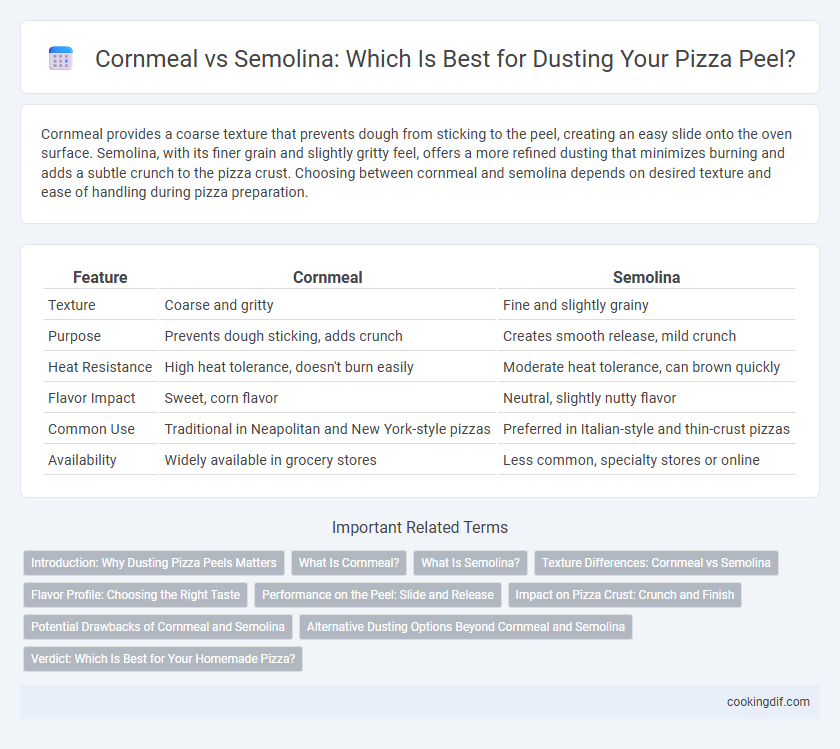Cornmeal provides a coarse texture that prevents dough from sticking to the peel, creating an easy slide onto the oven surface. Semolina, with its finer grain and slightly gritty feel, offers a more refined dusting that minimizes burning and adds a subtle crunch to the pizza crust. Choosing between cornmeal and semolina depends on desired texture and ease of handling during pizza preparation.
Table of Comparison
| Feature | Cornmeal | Semolina |
|---|---|---|
| Texture | Coarse and gritty | Fine and slightly grainy |
| Purpose | Prevents dough sticking, adds crunch | Creates smooth release, mild crunch |
| Heat Resistance | High heat tolerance, doesn't burn easily | Moderate heat tolerance, can brown quickly |
| Flavor Impact | Sweet, corn flavor | Neutral, slightly nutty flavor |
| Common Use | Traditional in Neapolitan and New York-style pizzas | Preferred in Italian-style and thin-crust pizzas |
| Availability | Widely available in grocery stores | Less common, specialty stores or online |
Introduction: Why Dusting Pizza Peels Matters
Dusting pizza peels with cornmeal or semolina is essential to prevent dough from sticking and ensure smooth transfer into the oven. Cornmeal offers a gritty texture that creates tiny air pockets, enhancing crispiness and facilitating quick release, while semolina's coarser grains resist moisture absorption and reduce tearing. Choosing the right dusting ingredient directly impacts the pizza's texture and baking efficiency, making it crucial for professional-quality results.
What Is Cornmeal?
Cornmeal is a coarse flour ground from dried corn kernels, commonly used for dusting pizza peels to prevent dough from sticking and to add a slight crunch to the pizza crust. Its gritty texture helps create a barrier between the dough and the peel, making it easier to slide the pizza into the oven without tearing. Cornmeal's natural sweetness and golden color can also enhance the flavor and appearance of the bottom crust.
What Is Semolina?
Semolina is a coarse, purified wheat middling made from durum wheat, commonly used in Italian cooking for its slightly gritty texture and high gluten content, which adds strength and elasticity to pizza dough. When dusting a pizza peel, semolina prevents sticking more effectively than regular flour by creating a coarse barrier, allowing the pizza to slide off smoothly into the oven. Cornmeal is also popular for dusting but lacks the gluten properties of semolina, making semolina a preferred choice for traditional Neapolitan and Roman pizzas.
Texture Differences: Cornmeal vs Semolina
Cornmeal provides a coarser texture that helps prevent dough from sticking to the peel while adding a slightly gritty, crunchy crust to pizza. Semolina, finer than cornmeal, offers a smoother, silkier texture that creates a more delicate barrier between dough and peel without imparting a pronounced crunch. Choosing between cornmeal and semolina affects the final pizza crust's texture, with cornmeal contributing crispness and semolina ensuring subtle lightness.
Flavor Profile: Choosing the Right Taste
Cornmeal offers a slightly sweet and nutty flavor that enhances the crust's taste when dusting a pizza peel, creating a rustic, traditional profile. Semolina provides a more subtle, mildly sweet flavor with a coarse texture that prevents sticking without overpowering the dough's natural taste. Selecting between cornmeal and semolina depends on whether you prefer a bolder corn flavor or a neutral texture that supports the pizza's primary ingredients.
Performance on the Peel: Slide and Release
Cornmeal creates a coarse barrier that prevents dough from sticking to the peel, offering excellent slide and release during pizza transfer into the oven. Semolina's slightly grittier texture provides superior grip on the dough surface while maintaining effortless slide on the peel. Both materials enhance peel performance, but semolina typically allows for smoother release due to its finer particle size and moisture resistance.
Impact on Pizza Crust: Crunch and Finish
Cornmeal creates a gritty, crunchy texture on the pizza crust, preventing dough from sticking to the peel while adding a rustic finish. Semolina offers a finer, slightly coarser grain that enhances the crust's crispness without excessive grittiness, contributing to a more refined bite. Choosing cornmeal results in a more textured base, whereas semolina provides a smoother, crunchier crust surface.
Potential Drawbacks of Cornmeal and Semolina
Cornmeal can burn easily under high oven temperatures, leading to a bitter taste and unsightly black specks on the pizza crust. Semolina, while offering a coarser texture for better dough release, may cause uneven baking due to its larger granules absorbing moisture unevenly. Both dusting agents require careful balance to avoid negative impacts on flavor and crust texture.
Alternative Dusting Options Beyond Cornmeal and Semolina
Alternative dusting options beyond cornmeal and semolina for pizza peels include rice flour, which prevents sticking without burning, and flour blends such as wheat or spelt that offer a balance between texture and heat resistance. Some pizzaiolos prefer using a mixture of tapioca starch and cornmeal to combine slip and durability during dough transfer. Dusting with fine-ground chickpea flour adds a subtle nutty flavor while effectively reducing dough adherence on the peel.
Verdict: Which Is Best for Your Homemade Pizza?
Cornmeal offers a coarser texture that prevents sticking and adds a subtle crunch to homemade pizza crusts, making it ideal for traditional pizzerias seeking authenticity. Semolina is finer with a slightly gritty feel, providing excellent non-stick properties and a crispier bottom crust preferred by artisanal pizza makers. Choosing between cornmeal and semolina depends on the texture and bite you want for your pizza, with cornmeal enhancing rustic charm and semolina delivering a delicate, golden finish.
Cornmeal vs semolina for dusting peel Infographic

 cookingdif.com
cookingdif.com